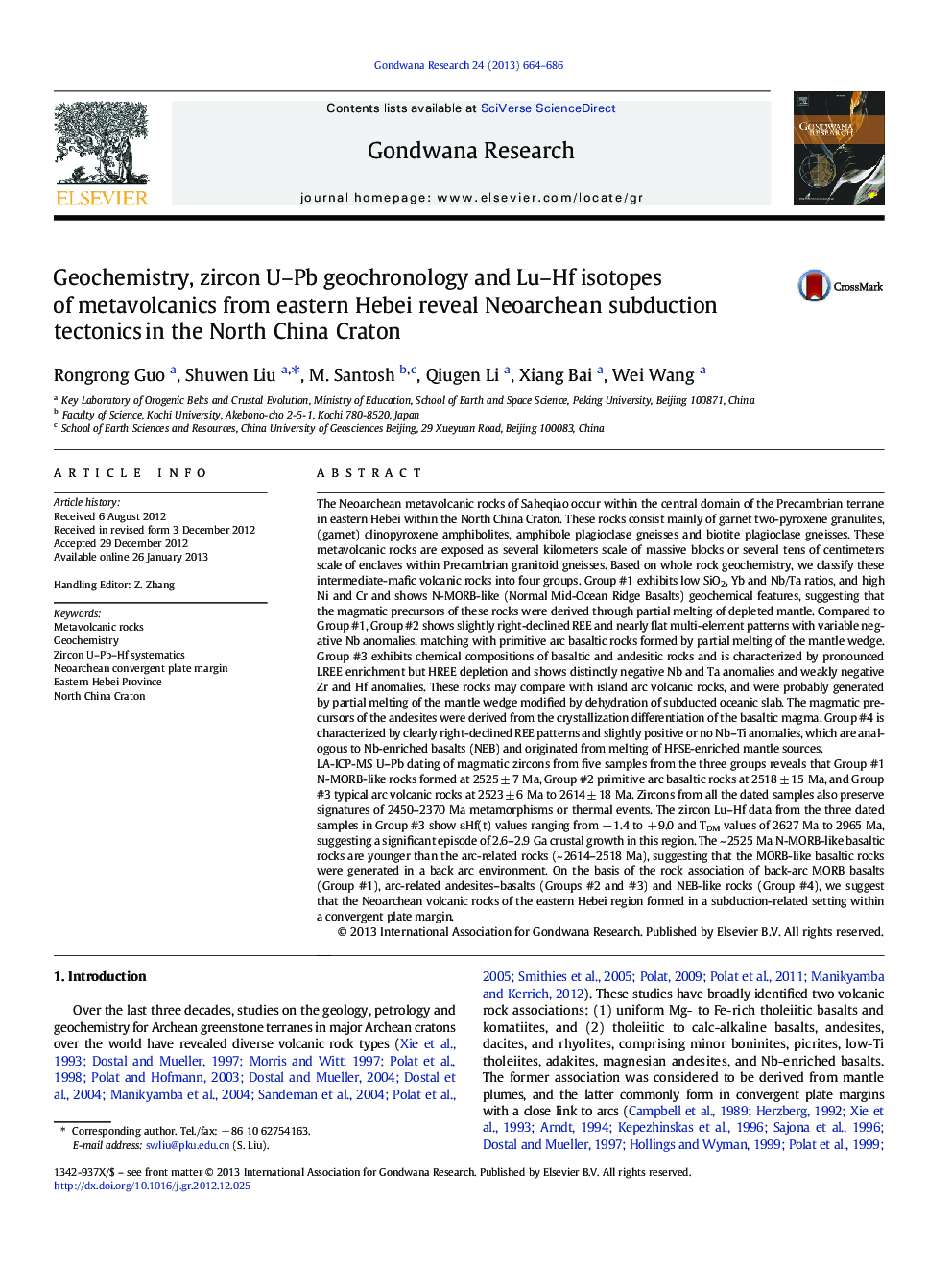| کد مقاله | کد نشریه | سال انتشار | مقاله انگلیسی | نسخه تمام متن |
|---|---|---|---|---|
| 4727319 | 1356369 | 2013 | 23 صفحه PDF | دانلود رایگان |

The Neoarchean metavolcanic rocks of Saheqiao occur within the central domain of the Precambrian terrane in eastern Hebei within the North China Craton. These rocks consist mainly of garnet two-pyroxene granulites, (garnet) clinopyroxene amphibolites, amphibole plagioclase gneisses and biotite plagioclase gneisses. These metavolcanic rocks are exposed as several kilometers scale of massive blocks or several tens of centimeters scale of enclaves within Precambrian granitoid gneisses. Based on whole rock geochemistry, we classify these intermediate-mafic volcanic rocks into four groups. Group #1 exhibits low SiO2, Yb and Nb/Ta ratios, and high Ni and Cr and shows N-MORB-like (Normal Mid-Ocean Ridge Basalts) geochemical features, suggesting that the magmatic precursors of these rocks were derived through partial melting of depleted mantle. Compared to Group #1, Group #2 shows slightly right-declined REE and nearly flat multi-element patterns with variable negative Nb anomalies, matching with primitive arc basaltic rocks formed by partial melting of the mantle wedge. Group #3 exhibits chemical compositions of basaltic and andesitic rocks and is characterized by pronounced LREE enrichment but HREE depletion and shows distinctly negative Nb and Ta anomalies and weakly negative Zr and Hf anomalies. These rocks may compare with island arc volcanic rocks, and were probably generated by partial melting of the mantle wedge modified by dehydration of subducted oceanic slab. The magmatic precursors of the andesites were derived from the crystallization differentiation of the basaltic magma. Group #4 is characterized by clearly right-declined REE patterns and slightly positive or no Nb–Ti anomalies, which are analogous to Nb-enriched basalts (NEB) and originated from melting of HFSE-enriched mantle sources.LA-ICP-MS U–Pb dating of magmatic zircons from five samples from the three groups reveals that Group #1 N-MORB-like rocks formed at 2525 ± 7 Ma, Group #2 primitive arc basaltic rocks at 2518 ± 15 Ma, and Group #3 typical arc volcanic rocks at 2523 ± 6 Ma to 2614 ± 18 Ma. Zircons from all the dated samples also preserve signatures of 2450–2370 Ma metamorphisms or thermal events. The zircon Lu–Hf data from the three dated samples in Group #3 show εHf(t) values ranging from − 1.4 to + 9.0 and TDM values of 2627 Ma to 2965 Ma, suggesting a significant episode of 2.6–2.9 Ga crustal growth in this region. The ~ 2525 Ma N-MORB-like basaltic rocks are younger than the arc-related rocks (~ 2614–2518 Ma), suggesting that the MORB-like basaltic rocks were generated in a back arc environment. On the basis of the rock association of back-arc MORB basalts (Group #1), arc-related andesites–basalts (Groups #2 and #3) and NEB-like rocks (Group #4), we suggest that the Neoarchean volcanic rocks of the eastern Hebei region formed in a subduction-related setting within a convergent plate margin.
Figure optionsDownload as PowerPoint slideHighlights
► The Saheqiao metavolcanics classified into four series of arc-related rocks
► Their magmatic precursors formed during 2614–2518 Ma in a subduction-related setting.
► The magmas formed by partial melting of the sub-arc and depleted mantle materials.
Journal: Gondwana Research - Volume 24, Issue 2, September 2013, Pages 664–686